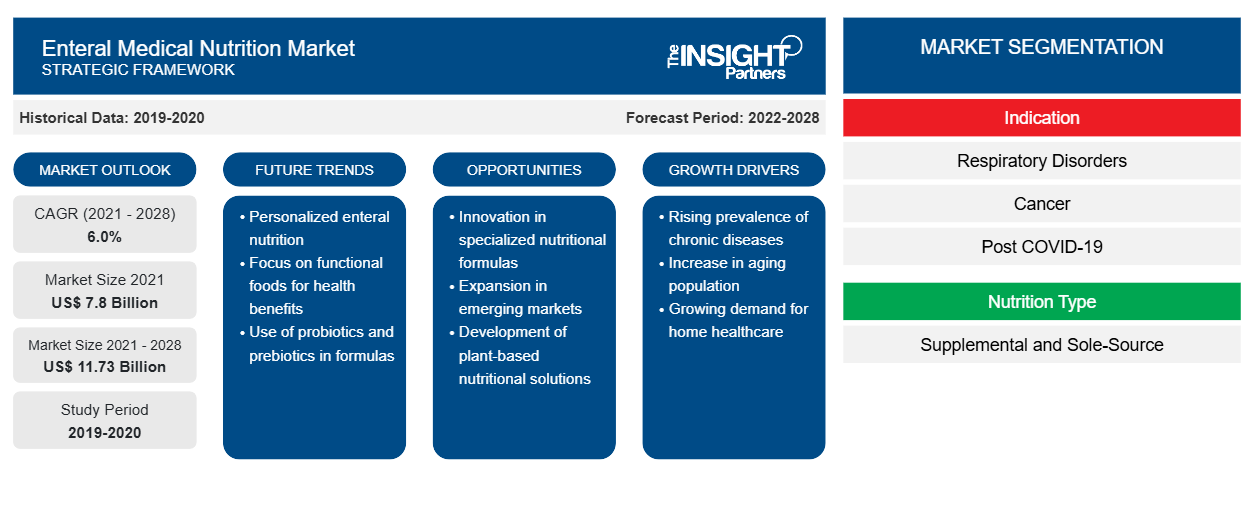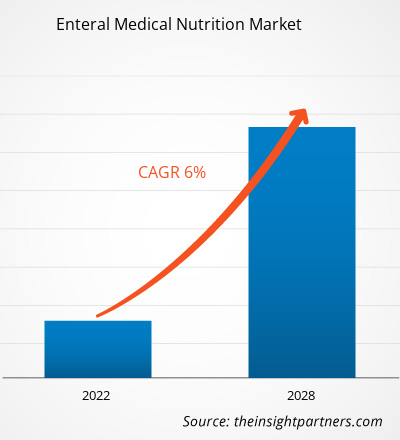The enteral medical nutrition market is projected to reach US$ 11,726.37 million by 2028 from US$ 7,803.45 million in 2021; it is expected to grow at a CAGR of 6.0% from 2022 to 2028.
Enteral nutrition (EN) is provided to patients whose energy and nutritional needs cannot be met by a regular food intake. The advantages of enteral intake over parenteral nutrition are well recognized. For most pediatric patients who are dependent on enteral nutrition, an age-adapted standard polymeric formula enriched with fibers is an appropriate choice.
The enteral medical nutrition market is segmented on the basis of indication, nutrition type, form, product, distribution channel, age group, and geography. By geography, the market is broadly segmented into North America, Europe, Asia Pacific, the Middle East & Africa, and South & Central America. The report offers insights and in-depth analysis of the market, emphasizing parameters, such as market trends and market dynamics, and the competitive analysis of the globally leading market players.
Customize This Report To Suit Your Requirement
You will get customization on any report - free of charge - including parts of this report, or country-level analysis, Excel Data pack, as well as avail great offers and discounts for start-ups & universities
Enteral Medical Nutrition Market: Strategic Insights

-
Get Top Key Market Trends of this report.This FREE sample will include data analysis, ranging from market trends to estimates and forecasts.
Market Insights
Increase in Prevalence of Cachexia
Cachexia is a multifunctional disease that causes extreme weight loss, skeletal muscle and adipose tissue loss, metabolic regulation imbalance, and food intake reduction. It is a serious clinical consequence of almost all chronic diseases when reaching advanced stages. According to NCBI (National Center for Biotechnology Information), in 2016, cachexia prevalence ranged from 5 to 15% in end-stage chronic heart failure. It is frequently occurring in patients suffering from chronic kidney disease, chronic obstructive pulmonary disease (COPD) , neurological disease, and rheumatoid arthritis. Mortality rates of cachexia patients range from 15 to 25% per year in patients with severe COPD and from 20 to 40% per year in patients with chronic heart failure or chronic kidney disease.
Cancer cachexia negatively affects the quality of life of cancer patients and reduces the effectiveness of anticancer chemotherapy and increases its toxicity, leading to growth in cancer-related mortality and medical resources expenditure. According to the Globocan, World Health Organization reported 9.6 million deaths and 18.1 million new cancer cases in 2018. In addition, cancer cachexia is a wasting syndrome that occurs in up to 80% of cancer patients. According to the article published by Department of Pulmonary and Critical Care Medicine, Beijing, the prevalence of cachexia is 87% in pancreatic and gastric cancer patients; 61% in colon, lung, and prostate cancer patients; and ~40% in breast cancer, sarcoma, leukemia, and Hodgkin lymphoma patients. In addition, 20% of the total cancer-related deaths are due to cachexia. In cachexia, the nutrients in the body decrease. Therefore, it is necessary to provide external nutrients to continue the treatment for cancer and COPD. Doctors prefer enteral route to provide these required nutrients to the patient. Therefore, growing prevalence of cachexia due to the rising incidence of various chronic diseases fuels the growth of the enteral medical nutrition market.
Indication Insights
Based on indication, the enteral medical nutrition market is segmented into respiratory disorders, cancer, post COVID-19, gastrointestinal disorders, liver failure, and others. The market for the respiratory disorders segment is further segmented into chronic obstructive pulmonary disease (COPD), respiratory failure, cystic fibrosis, and others. The market for the cancer segment is subsegmented into cancer cachexia, cachexia with COPD, and others. The market for the gastrointestinal disorders segment is further segmented into bowel obstruction, short bowel obstruction, crohn’s disease, and others. The respiratory disorders segment held the largest market share in 2021. However, the cancer segment is anticipated to register the highest CAGR of 7.6% in the market during the forecast period. Pulmocare manufactured by Abbott is designed for people suffering from COPD, cystic fibrosis, or respiratory failure. The high-calorie, modified carbohydrate and fat, enteral formula can help these patients reduce diet-induced carbon dioxide production.
Nutrition Type Insights
Based on nutrition type, the global enteral medical nutrition market is bifurcated into supplemental and sole-source. The supplemental segment held a larger market share in 2021. However, the sole-source segment is anticipated to register a higher CAGR during the forecast period. The patients that receive the supplemental source of nutrition are subjected to stay within the hospital for a prolonged period. Enteral formulas enriched in omega-3 fatty acids, ribonucleic acids, and glutamine or arginine are provided to patients. For instance, Jevity is a nutritional formula designed to provide supplemental or sole-source nutrition for adults who are on short- or long-term tube-feeding regimens. The same is available in caloric densities of 1.0, 1.2, and 1.5 calories per milliliter. Jevity formulas can also help meet patients’ daily protein and fiber needs.
Form Insights
Based on form, the global enteral medical nutrition market is segmented into powder, liquid, and semi-solid. The semi-solid segment held the largest market share in 2021 and is anticipated to register the highest CAGR during the forecast period.
Product Insights
Based on product, the global enteral medical nutrition market is segmented into standard protein diet, high protein diet, fruit juice based oral nutrient, and others. The standard protein diet segment held the largest share of the market in 2021. However, the fruit juice based oral nutrient segment is anticipated to register the highest CAGR during the forecast period.
Distribution Channel Insights
Based on distribution channel, the enteral medical nutrition market is segmented into hospital pharmacies, retail stores, and other pharmacies. The hospital pharmacies segment held the largest share of the market in 2021. However, the retail stores segment is anticipated to register the highest CAGR during the forecast period.
Age Group Insights
Based on age, the enteral medical nutrition market is bifurcated into child (till 18 years) and adult (18+years). The adult (18+years) held a larger share of the market in 2021. However, the child (till 18 years) segment is anticipated to register a higher CAGR during the forecast period.
Enteral Medical Nutrition Market Regional InsightsThe regional trends and factors influencing the Enteral Medical Nutrition Market throughout the forecast period have been thoroughly explained by the analysts at The Insight Partners. This section also discusses Enteral Medical Nutrition Market segments and geography across North America, Europe, Asia Pacific, Middle East and Africa, and South and Central America.
Enteral Medical Nutrition Market Report Scope
| Report Attribute | Details |
|---|---|
| Market size in 2021 | US$ 7.8 Billion |
| Market Size by 2028 | US$ 11.73 Billion |
| Global CAGR (2021 - 2028) | 6.0% |
| Historical Data | 2019-2020 |
| Forecast period | 2022-2028 |
| Segments Covered |
By Indication
|
| Regions and Countries Covered |
North America
|
| Market leaders and key company profiles |
|
Enteral Medical Nutrition Market Players Density: Understanding Its Impact on Business Dynamics
The Enteral Medical Nutrition Market is growing rapidly, driven by increasing end-user demand due to factors such as evolving consumer preferences, technological advancements, and greater awareness of the product's benefits. As demand rises, businesses are expanding their offerings, innovating to meet consumer needs, and capitalizing on emerging trends, which further fuels market growth.

- Get the Enteral Medical Nutrition Market top key players overview
Enteral Medical Nutrition Market – by Region
By geography, the global market is segmented into North America (the US, Canada, and Mexico), Europe (the UK, Germany, France, Italy, Spain, and the Rest of Europe), Asia Pacific (China, Japan, India, Australia, South Korea, and the Rest of Asia Pacific), the Middle East & Africa (the UAE, Saudi Arabia, South Africa, and the Rest of the Middle East & Africa), and South & Central America (Brazil, Argentina, and the Rest of South & Central America).
Company Profiles
Abbott Laboratories; Nutricia; Fresenius Kabi AG; B. Braun Melsungen AG; NESTLE S.A.; Meiji Holdings Co., Ltd.; Smartfish AS; DSM; Hormel Foods Corporation; and Global Health Products, Inc. are among the major players in the enteral medical nutrition market.
Frequently Asked Questions
Which segment is dominating the enteral medical nutrition market?
Who are the major players in market the enteral medical nutrition market?
What are the driving factors for the enteral medical nutrition market across the country?
What is the enteral medical nutrition market?
- Historical Analysis (2 Years), Base Year, Forecast (7 Years) with CAGR
- PEST and SWOT Analysis
- Market Size Value / Volume - Global, Regional, Country
- Industry and Competitive Landscape
- Excel Dataset
Recent Reports
Related Reports
Testimonials
Reason to Buy
- Informed Decision-Making
- Understanding Market Dynamics
- Competitive Analysis
- Identifying Emerging Markets
- Customer Insights
- Market Forecasts
- Risk Mitigation
- Boosting Operational Efficiency
- Strategic Planning
- Investment Justification
- Tracking Industry Innovations
- Aligning with Regulatory Trends





















 Get Free Sample For
Get Free Sample For